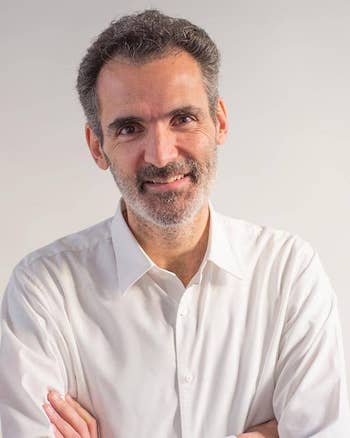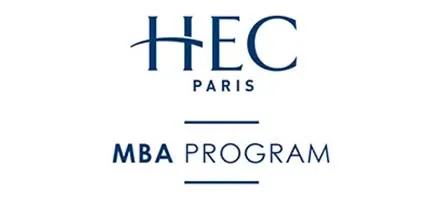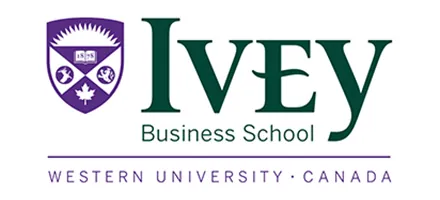Online teaching, as business schools everywhere have discovered, has downsides. But it also has big benefits, particularly when it comes to MBA students’ experience, says Olivier Sibony, associate professor of strategy and business policy at HEC Paris.
“It actually forces you to vary the formats of the class and of the interactions much more,” says Sibony, a long-time management consultant and lecturer at London Business School, Oxford Saïd, and elsewhere. “Because online, it becomes blindingly obvious that if you spend more than 10 minutes talking, you lose them. So it forces you to rethink your teaching plan to have a lot more exercises, a lot more interaction, a lot more questions, and a lot more breaks. And that is beneficial, too. I mean, I won’t teach the same way in the classroom now that I have some experience at online.”
Sibony is the author of You’re About To Make A Terrible Mistake, first released in France in 2015 and re-released this spring, which uses case studies as examples of how cognitive biases routinely lead all of us — from the lowly MBA student to the most successful titans of commerce — into nine common decision-making traps. The best way to avoid these biases and traps? By leveraging collective intelligence to help leaders make the best decisions possible. It’s chock full of lessons not only for the corporate world but the classroom, as well.
MAKING SENSE OF THE MISTAKES PEOPLE MAKE
The book “mixes my experience as a consultant working with decision-makers and my research, since I became an academic, trying to make sense of the mistakes that people make,” says Sibony, who provides 40 methods for avoiding the nine traps and crafting an effective decision-making architecture in an organization. “And the funny thing about students is that when I teach this class to undergraduates, which I do at HEC Paris, they look at me like I’m dumb. And they say, ‘What do you mean people make those stupid mistakes? I mean, aren’t managers supposed to make the right decisions?’ They simply have no clue of the fact that this sort of irrationality actually exists.
“Whereas MBAs, when you start sharing those stories and sharing those concepts, they say, ‘Ah, at last someone who talks about the world like it is. Someone who talks about the organizations that we’ve lived in, that we’ve experienced, and the way decisions are really made in those organizations, not the theoretical perspective of economists or something disconnected from reality.'”
Poets&Quants talked with Sibony recently from his home in Paris. The interview that follows is edited for length and clarity.
How much of this book grew out of the classroom, particularly the MBA classroom? Did this come out of what you teach your students?

And I just found that there wasn’t anything on the market for business books about how to avoid cognitive biases that I could endorse. So I put my own book into English. And now we have it in quite a few other languages too, oddly enough. But anyway, it came out of a need expressed by the classroom. It mixes my experience as a consultant working with decision makers and my research, since I became an academic, trying to make sense of the mistakes that people make.
And the funny thing about students, to get to your question in an oblique way, is that when I teach this class to undergraduates, which I do at HEC Paris, they look at me like I’m dumb. And they say, “What do you mean people make those stupid mistakes? I mean, aren’t managers supposed to make the right decisions?” They simply have no clue of the fact that this sort of irrationality actually exists.
Whereas MBAs, when you start sharing those stories and sharing those concepts, they say, “Ah, at last someone who talks about the world like it is. Someone who talks about the organizations that we’ve lived in, that we’ve experienced, and the way decisions are really made in those organizations, not the theoretical perspective of economists or something disconnected from reality.”
So I think it comes out of the classroom in the sense that MBAs specifically really find that it really echoes their experience.
But it can also go back into the classroom as well — you’ll be talking about some of this stuff in future classes.
Of course. Yeah. And I hope lots of other professors are going to be talking about it business classes.
When the first French edition of the book came out, it was the day of the terrorist attacks in Paris in 2015. And then when the new version came out, it was not literally the day, but a few days before the lockdown was decided in France. So I’m now telling people, “If you want to know when not to travel, just ask me when my next book is coming out. I can sort of guarantee you that all hell is going to break loose.” That will be next year. We don’t have a date yet.
But when the book was relaunched in mid-July, I got some inquiries from professors in various MBA programs saying, “Hey, I’d like to teach this. How do we get our hands on it?” And we sent them copies and we’ll see what they want to do with it. But it could be used as a textbook. It’s not intended primarily as a textbook, but it has the sources and the references and the academic rigor that you would expect in a textbook. Not that it’s a big market necessarily, but I do hope that some of my colleagues will want to use it to teach behavioral decision making.
You’re teaching behavioral strategy again this year, right? Will it be remote or in the classroom?

Olivier Sibony. HEC Paris photo
A mix. The class uses a lot of interactive exercises and teamwork, and that is really hard to do in the classroom these days. The big, cool thing about this situation is that the things that add the most value when you do them face-to-face are precisely the ones that you cannot do face-to-face. You can’t do lecture face-to-face. But frankly, the lecture works online, too. What really doesn’t work that well online is to get around the table, roll up your sleeves, and work in a team of four or five people. And that is impossible these days.
But we’ll find ways to replicate this online. I’ve had some — not with the MBAs — but I had some experiences already of getting people to work in small groups online. And it works surprisingly well.
And this is an aside, but the whole online situation that we have now, there is a big silver lining to this thing. I mean, I hate to say that the Covid-19 crisis has a silver lining, because it sounds callous. But in terms of teaching, we are discovering that online teaching of course does have downsides. What doesn’t? But it also has big benefits, big advantages in terms of the quality of the students’ experience.
Such as?
An obvious one is that the introverts who never raise their hands to ask a question in a room of 70, or the people whose English is not very good and who are too shy to do it, don’t hesitate to ask you the question in the chat box. And conversely, the loudmouth who tends to monopolize the speaking time because they haven’t realized that it’s the quality not the quantity of the participation that matters, do not disrupt as much as they normally would.
That’s one. Another one is that it forces you — and you know you should always do that as a professor — but it actually forces you to vary the formats of the class and of the interactions much more. Because online, it becomes blindingly obvious that if you spend more than 10 minutes talking, you lose them. So it forces you to rethink your teaching plan to have a lot more exercises, a lot more interaction, a lot more questions, and a lot more breaks. And that is beneficial, too. I mean, I won’t teach the same way in the classroom now that I have some experience at online.
Right. It’s going to change things going forward. When you finally get back to fully in person teaching, it’ll be different.
And of course, don’t misunderstand me — I look forward to that. I mean, it’s not like I don’t like seeing my students. I would much prefer to be in the same room with them. But it’s not the disaster that some people initially were saying it was, that in fact I was fearing it would be. I’m finding it’s a lot better than I thought.
If you were writing this book now in the middle of Covid, would Covid find its way into it? Would there be a 10th trap?
Oh, you bet. It wouldn’t be another chapter, but there would be a Covid example in each chapter. I actually gave an online talk at the height of the crisis about how the response to the Covid-19 crisis in its early stages was a perfect illustration of several of the cognitive biases. I first gave it in French because I was asked to do it. It got something like 300,000 views on YouTube, which for a one-hour conference with PowerPoint slides and some guy with a bad shave and a bad connection is a bit unheard of. So the Covid-19 and bias story works very well. And so there’s a lot of examples there.
What parallel can we find to graduate business education?
Well, in terms of business education, an example that comes to mind purely because I was reading about it a few days ago is this old story that we hear all the time that Zuckerberg didn’t complete his college and neither did Bill Gates, and all these guys didn’t need an education to be successful entrepreneurs. And that’s a classic example of survivorship bias. We look at those successful guys. But if you look actually at the rate of people, if you look at the population of say, Fortune 500 CEOs or whatever, 95% of them — not the real number, but something like that — will actually have completed college and many will actually have had an MBA under their belt.
So this sort of reasoning that people make about the value of an MBA, or the lack thereof in that case, is a classic example of the bias. And now what would be another example? People who say, “I want to go to Wharton because it’s always been the best MBA, or to Harvard it because it’s always been the best MBA,” aren’t asking the right question. The right question is, where do they get the best value? And what is the best value in an MBA today, not in the MBAs whose results we see in the people who are 50 years old now.
So that’s a classic example of question substitution. The question I’m asking now is actually a very difficult question. I can tell from your tone when you say, “Yeah.” Yeah. That’s a very difficult question. What makes a good MBA? Well, you have a healthy business trying to help people answer that question because it’s not an easy question.
And as always, when you have a difficult question, the simple question that comes to mind with a simple answer, that is a very tempting substitute over the difficult question. The easy question is, which MBA is the best known, or has the best reputation? So if you have two options and you need to choose between them, it’s very tempting to pick the one that simply has the best brand recognition, history, etc. But actually that’s an example of asking the wrong question — of answering the wrong question. Substituting an easier question for the difficult but relevant question — that’s an example of what I call pattern recognition bias.
You write about groupthink traps. There must be many groupthink traps in graduate business education.
What first comes to mind is related to a good and bad use of the case method. I’m not thinking of anyone in particular, but there is a better way to use the case method than some students understand the case method to be, and obviously it’s our fault, right? I mean, they understand it in one way, because we haven’t been careful enough in explaining to them that that’s not the right way. They view it as a sort of library of stories, of anecdotes, from which we can reason by analogy. And that is, of course, what experience is supposed to teach you, and viewed in that way the case method is the sort of acceleration of your experience. It’s meant to give you knowledge in 18 or 24 months that you will have been faced at least intellectually with a number of situations, and you will recognize solutions to those problems.
But if you think about the underlying logic, the presumption there is that the situation that you’re going to be dealing with is directly comparable to the one in the case. And of course it never is. So the leap that you need to make in order to get the best out of the casebook is to look at the case, look at the solution, or discuss the case and understand what the possible solutions are in the case, and learn from that case. The theory, the insights, the concepts, the tools there are universally applicable, so they’ll learn their limits. That they’re applicable in many situations, less universally — but also learn their limits and learn where they are not applicable, so that you will be able to apply the learnings of the case method in the relevant settings and not in the places where they’re not relevant.
Now is that groupthink? I don’t think it’s groupthink per se. I think it’s a very good method, but I think there’s a trap in our thinking — it’s probably a bias, but it’s older than that — which is the tendency to reason by analogy into reasons, age, or anecdotes. The case method, there’s a very good way to use it, and I do. At least I try to. When not carefully used, you can actually encourage misuse.
You said you were working on another book. Is it something that comes out of your teaching?
I’m working on another book that should come out in April or May. We don’t have a precise date yet, which I am racing, bluntly, with two coauthors, and which actually is not coming out of their teaching. It’s more theoretical book about judgment and decision making, but at a more conceptual level to itself.
DON’T MISS WHAT IT’S LIKE TO GET AN MBA AT HEC PARIS and HOW TO TACKLE THE HEC PARIS ESSAYS










